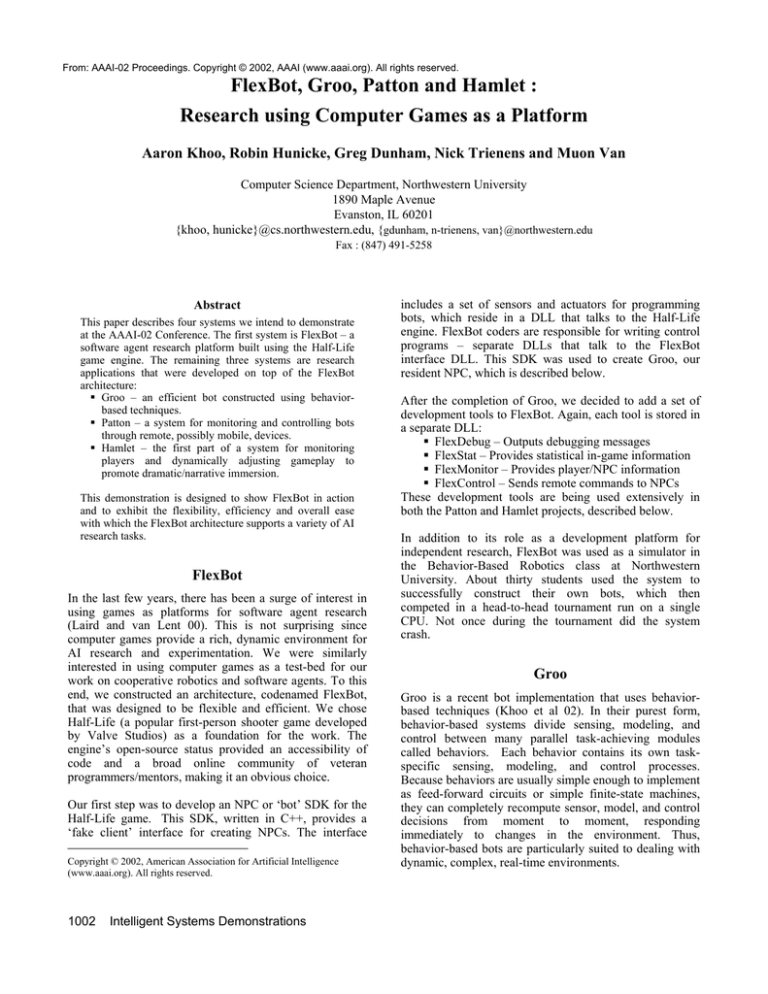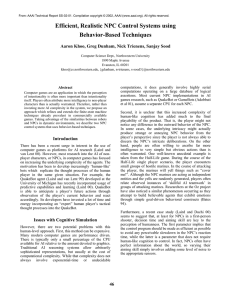
From: AAAI-02 Proceedings. Copyright © 2002, AAAI (www.aaai.org). All rights reserved.
FlexBot, Groo, Patton and Hamlet :
Research using Computer Games as a Platform
Aaron Khoo, Robin Hunicke, Greg Dunham, Nick Trienens and Muon Van
Computer Science Department, Northwestern University
1890 Maple Avenue
Evanston, IL 60201
{khoo, hunicke}@cs.northwestern.edu, {gdunham, n-trienens, van}@northwestern.edu
Fax : (847) 491-5258
Abstract
This paper describes four systems we intend to demonstrate
at the AAAI-02 Conference. The first system is FlexBot – a
software agent research platform built using the Half-Life
game engine. The remaining three systems are research
applications that were developed on top of the FlexBot
architecture:
! Groo – an efficient bot constructed using behaviorbased techniques.
! Patton – a system for monitoring and controlling bots
through remote, possibly mobile, devices.
! Hamlet – the first part of a system for monitoring
players and dynamically adjusting gameplay to
promote dramatic/narrative immersion.
This demonstration is designed to show FlexBot in action
and to exhibit the flexibility, efficiency and overall ease
with which the FlexBot architecture supports a variety of AI
research tasks.
FlexBot
In the last few years, there has been a surge of interest in
using games as platforms for software agent research
(Laird and van Lent 00). This is not surprising since
computer games provide a rich, dynamic environment for
AI research and experimentation. We were similarly
interested in using computer games as a test-bed for our
work on cooperative robotics and software agents. To this
end, we constructed an architecture, codenamed FlexBot,
that was designed to be flexible and efficient. We chose
Half-Life (a popular first-person shooter game developed
by Valve Studios) as a foundation for the work. The
engine’s open-source status provided an accessibility of
code and a broad online community of veteran
programmers/mentors, making it an obvious choice.
Our first step was to develop an NPC or ‘bot’ SDK for the
Half-Life game.1 This SDK, written in C++, provides a
‘fake client’ interface for creating NPCs. The interface
Copyright © 2002, American Association for Artificial Intelligence
(www.aaai.org). All rights reserved.
1002
Intelligent Systems Demonstrations
includes a set of sensors and actuators for programming
bots, which reside in a DLL that talks to the Half-Life
engine. FlexBot coders are responsible for writing control
programs – separate DLLs that talk to the FlexBot
interface DLL. This SDK was used to create Groo, our
resident NPC, which is described below.
After the completion of Groo, we decided to add a set of
development tools to FlexBot. Again, each tool is stored in
a separate DLL:
! FlexDebug – Outputs debugging messages
! FlexStat – Provides statistical in-game information
! FlexMonitor – Provides player/NPC information
! FlexControl – Sends remote commands to NPCs
These development tools are being used extensively in
both the Patton and Hamlet projects, described below.
In addition to its role as a development platform for
independent research, FlexBot was used as a simulator in
the Behavior-Based Robotics class at Northwestern
University. About thirty students used the system to
successfully construct their own bots, which then
competed in a head-to-head tournament run on a single
CPU. Not once during the tournament did the system
crash.
Groo
Groo is a recent bot implementation that uses behaviorbased techniques (Khoo et al 02). In their purest form,
behavior-based systems divide sensing, modeling, and
control between many parallel task-achieving modules
called behaviors. Each behavior contains its own taskspecific sensing, modeling, and control processes.
Because behaviors are usually simple enough to implement
as feed-forward circuits or simple finite-state machines,
they can completely recompute sensor, model, and control
decisions from moment to moment, responding
immediately to changes in the environment. Thus,
behavior-based bots are particularly suited to dealing with
dynamic, complex, real-time environments.
In our system, Groo bots run concurrently with the HalfLife game server on the same physical machine. They are
both efficient and stable. We have successfully run up to
31 bots on a server; the game engine itself placed a limited
of 32 players in a game total, and the final spot had to be
reserved for the sole human player.
While we have yet to run empirical studies similar to
(Laird and Duchi 00), but anecdotal evidence indicates that
our system has succeeded in presenting bots with realistic
adversarial behavior. The Ledgewalker and Groo bots
have been playtested at Northwestern by people familiar
with first-person shooters, and during demonstrations at
IJCAI-2001. In general, the reaction was positive, and
most players felt that the bots exhibited behaviors
associated with human death-match players.
Patton
Patton is an effort to develop a system for controlling and
monitoring FlexBot from a remote device. The idea here is
that the user is now a commander in charge of dispensing
team- into the system at appropriate times.
At present, Patton augments the development tools
provided by FlexBot with four new HTML-driven
components:
! StatServer –Displays a set of in-game statistics,
such as number of enemy kills, friendly kills,
suicides, etc. Statistics can be sorted by individual
bots, team or behavior type.
! BigBrother – Provides the user with an overhead
2D view of the current map, with player positions
updated in real-time. Information is available by
simply clicking on a particular player.
! RemoteConsole – Allows the commander to
create/remove bots in Half-Life, set their skill
levels, and switch their behaviors dynamically.
! VirtualJoystick – Allows users to directly control
the movements of a bot in the game. Although
primitive, this proof of concept shows that we can
command the bots from a remote device.
the player’s inventory and strategically places aid (health,
weapons, armor and ammo) within reach at critical points
during the action.
Our aim is to create an environment that is both responsive
and responsible: a game should never be so difficult that it
becomes impossible, nor should it be so easy that it
becomes boring. This means lowering player frustration
(needless hunting for ammo or health, repeated death at the
same point) while maintaining the dramatic tension of the
game (the player’s experience of challenge, struggle and
triumph at the controls).
Many commercial games already have some type of
difficulty adjustment – most often the traditional
“easy/medium/hard” setup options.
Our system is
designed to explore the advantages and disadvantages of
different techniques for representing and reasoning about
uncertainty in game environments, to see how these
approaches can be extended and combined to create
flexible, interactive experiences that adjust on the fly.
In its current form, the Hamlet system is responsible for
altering only the physical interactions of a game
environment. Future work will extend the system’s
capabilities for managing the strategic and narrative
elements of gameplay, such as the placement of enemies,
obstacles and information within the game world. Our
ultimate goal is a system that combines local and global
changes to create a responsive game environment where
every action has a measured and dramatic consequence.
Reference
R.C. Arkin(1998) Behavior-based Robotics. MIT Press.
Cambridge, MA.
A. Khoo, G. Dunham , N. Trienens , S. Sood (2002)
Efficient, Realistic NPC Control Systems using BehaviorBased Techniques. To appear in 2002 AAAI Spring
Symposium on Artificial Intelligence and Interactive
Entertainment.
Because Patton is entirely HTML-driven, any browserenabled device will be able to utilize Patton’s functions.
We have successfully used Patton on a number of mobile
devices as well as desktops, and continue to develop and
refine the system. Our goal is an integrated demonstration
of high-level control, in which a commander can make
tactical-level decisions for bots to carry out autonomously.
J. Bates(1994) The Role of Emotion in Believable Agents.
Communications of the ACM, vol. 37, no. 7, pp. 122-125
Hamlet
J.E. Laird and M. van Lent(2000) Human-level AI’s Killer
Application : Interactive Computer Games. AAAI Fall
Symposium Technical Report, North Falmouth,
Massachusetts, 2000, 80-97.
Hamlet is a decision-theoretic system designed to manage
the flow of gameplay experiences by supplying “just-intime” aid to a player. Using techniques drawn from
probability and utility theory, the Hamlet system examines
J.E. Laird and J.C. Duchi(2000) Creating Human-Like
Synthetic Characters with Multiple Skill Levels: A Case
Study Using the Soar Quakebot AAAI 2000 Fall
Symposium Series : Simulating Human Agents, November
2000 : AAAI Technical Report FS-00-03
Intelligent Systems Demonstrations
1003





